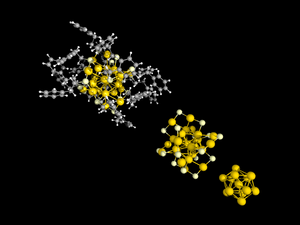This article has multiple issues. Please help improve it or discuss these issues on the talk page. (Learn how and when to remove these template messages)
|
Monolayer protected clusters (MPCs) are one type of nanoparticles or clusters of atoms. A single MPC contains three main parts: metallic core, protective ligand layer and metal-ligand interface between, each defined by their distinctive chemical and structural environments.[1] The main part of a MPC is a metallic core, which can consist of a single metal or it can be a mixture of metals. Bare metal particles tend to be reactive. They usually react with environment or with other particles making larger structures. Ligand layer is used to protect them, so that the particle size is preserved. Ligands are usually some organic molecules and they are bound to metallic core via some linking atoms such as sulfur or phosphorus forming thiol and phosphine ligands. However, there are alkynyl and carbene protected MPCs,[2][3] where carbon is directly bound to metal atoms. Ligand layer can consist of a single type of ligands, like in the case of thiolate-protected gold clusters, or it can contain several different molecules. Even though the ligand layer is usually used to passivate a nanoparticle, it is not a passive part of the MPCs. For example, ligands can be functionalized to work in specific applications such as binding to surfaces or acting as a carrier for other molecules. Ligand layer also contributes to the total electronic structure of the particle, which furthermore affects the superatomic nature of the particle.[1]

In order to fully understand how MPCs work, one has to solve their atomic structures. One of the most common ways is to use X-ray crystallography. There are a large amount of these structures found but they are scattered over different sources. This article is designed to be a list of known structures of MPCs focusing on experimentally determined ones. MPCs are divided to tables according to their cores. Within the tables they are sorted according to the amount of metal atoms from smallest to largest. If there several clusters with similar core sizes, earlier published is listed first. The last table contains some structures which are partially determined experimentally and partially predicted by theoretical calculations. Every table lists the chemical formula of the MPC, the full reference to the publication and a their shortened DOI code with a link to the publication. There are three main ways to access the structure information. The first one is to go to the webpage of the original publication and see if there is supplementary information file containing the data. The second approach is to use the listed DOI and search the structure from the Cambridge Structural Database (CSD)[4] or Crystallography Open Database (COD).[5] There one can easily download the structure, if authors have submitted their crystallographic data. Some crystal structures are published in Protein Data Bank (PDB),[6] in which case corresponding accession code is listed after the DOI. The third option is for the situations, where two first ones don't work and the data is really needed. One can check who is the corresponding author of the publication and ask politely for the data.
- ^ a b Tatsuya Tsukuda and Hannu Häkkinen. Protected Metal Clusters: From Fundamentals to Applications. Elsevier Ltd. 2015, Amsterdam, Netherlands, ISBN 978-0-08-100086-1
- ^ Prasenjit Maity, Hironori Tsunoyama, Miho Yamauchi, Songhai Xie and Tatsuya Tsukuda. Organogold Clusters Protected by Phenylacetylene. J. Am. Chem. Soc. 2011, 133, 50, 20123–20125, DOI:10.1021/ja209236n
- ^ Eleanor C. Hurst, Karen Wilson, Ian J. S. Fairlamb and Victor Chechik. N-Heterocyclic carbene coated metal nanoparticles. New J. Chem., 2009, 33, 9, 1837-1840, DOI:10.1039/B905559B
- ^ https://www.ccdc.cam.ac.uk/
- ^ "Crystallography Open Database".
- ^ https://www.rcsb.org/
